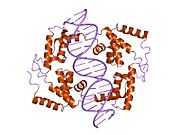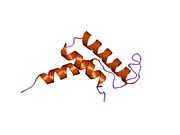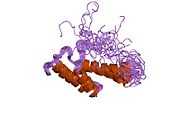HNF1A
HNF1 homeobox A (hepatocyte nuclear factor 1 homeobox A), also known as HNF1A, is a human gene.[1][2]
The protein encoded by this gene is a transcription factor that is highly expressed in the liver and is involved in the regulation of the expression of several liver-specific genes.[3]
Interactions
HNF1A has been shown to interact with:
See also
References
- ↑ Szpirer C, Riviere M, Cortese R, Nakamura T, Islam MQ, Levan G, Szpirer J (June 1992). "Chromosomal localization in man and rat of the genes encoding the liver-enriched transcription factors C/EBP, DBP, and HNF1/LFB-1 (CEBP, DBP, and transcription factor 1, TCF1, respectively) and of the hepatocyte growth factor/scatter factor gene (HGF)". Genomics 13 (2): 293–300. doi:10.1016/0888-7543(92)90245-N. PMID 1535333.
- ↑ Vaxillaire M, Boccio V, Philippi A, Vigouroux C, Terwilliger J, Passa P, Beckmann JS, Velho G, Lathrop GM, Froguel P (April 1995). "A gene for maturity onset diabetes of the young (MODY) maps to chromosome 12q". Nat. Genet. 9 (4): 418–23. doi:10.1038/ng0495-418. PMID 7795649.
- ↑ Courtois G, Morgan JG, Campbell LA, Fourel G, Crabtree GR (October 1987). "Interaction of a liver-specific nuclear factor with the fibrinogen and alpha 1-antitrypsin promoters". Science 238 (4827): 688–92. doi:10.1126/science.3499668. PMID 3499668.
- ↑ 4.0 4.1 4.2 4.3 Soutoglou E, Papafotiou G, Katrakili N, Talianidis I (April 2000). "Transcriptional activation by hepatocyte nuclear factor-1 requires synergism between multiple coactivator proteins". J. Biol. Chem. 275 (17): 12515–20. doi:10.1074/jbc.275.17.12515. PMID 10777539.
- ↑ Ban N, Yamada Y, Someya Y, Miyawaki K, Ihara Y, Hosokawa M, Toyokuni S, Tsuda K, Seino Y (May 2002). "Hepatocyte nuclear factor-1alpha recruits the transcriptional co-activator p300 on the GLUT2 gene promoter". Diabetes 51 (5): 1409–18. doi:10.2337/diabetes.51.5.1409. PMID 11978637.
- ↑ Ewing RM, Chu P, Elisma F, Li H, Taylor P, Climie S, McBroom-Cerajewski L, Robinson MD, O'Connor L, Li M, Taylor R, Dharsee M, Ho Y, Heilbut A, Moore L, Zhang S, Ornatsky O, Bukhman YV, Ethier M, Sheng Y, Vasilescu J, Abu-Farha M, Lambert JP, Duewel HS, Stewart II, Kuehl B, Hogue K, Colwill K, Gladwish K, Muskat B, Kinach R, Adams SL, Moran MF, Morin GB, Topaloglou T, Figeys D. "Large-scale mapping of human protein-protein interactions by mass spectrometry". Mol. Syst. Biol. 3: 89. doi:10.1038/msb4100134. PMC 1847948. PMID 17353931.
- ↑ Sourdive DJ, Transy C, Garbay S, Yaniv M (April 1997). "The bifunctional DCOH protein binds to HNF1 independently of its 4-alpha-carbinolamine dehydratase activity". Nucleic Acids Res. 25 (8): 1476–84. doi:10.1093/nar/25.8.1476. PMC 146627. PMID 9092652.
- ↑ Hines RN, Luo Z, Cresteil T, Ding X, Prough RA, Fitzpatrick JL, Ripp SL, Falkner KC, Ge NL, Levine A, Elferink CJ (May 2001). "Molecular regulation of genes encoding xenobiotic-metabolizing enzymes: mechanisms involving endogenous factors". Drug Metab. Dispos. 29 (5): 623–33. PMID 11302926.
- ↑ Rufibach LE, Duncan SA, Battle M, Deeb SS (July 2006). "Transcriptional regulation of the human hepatic lipase (LIPC) gene promoter". J. Lipid Res. 47 (7): 1463–77. doi:10.1194/jlr.M600082-JLR200. PMID 16603721.
- ↑ 10.0 10.1 Bulla GA, Kraus DM (December 2004). "Dissociation of the hepatic phenotype from HNF4 and HNF1alpha expression". Biosci. Rep. 24 (6): 595–608. doi:10.1007/s10540-005-2794-8. PMID 16158197.
Further reading
- Eastman Q, Grosschedl R (1999). "Regulation of LEF-1/TCF transcription factors by Wnt and other signals". Curr. Opin. Cell Biol. 11 (2): 233–40. doi:10.1016/S0955-0674(99)80031-3. PMID 10209158.
- Bioulac-Sage P, Blanc JF, Rebouissou S, Balabaud C, Zucman-Rossi J (2007). "Genotype phenotype classification of hepatocellular adenoma". World J. Gastroenterol. 13 (19): 2649–54. doi:10.3748/wjg.v13.i19.2649. PMID 17569132.
PDB gallery |
|---|
| | 1ic8: HEPATOCYTE NUCLEAR FACTOR 1A BOUND TO DNA : MODY3 GENE PRODUCT |
| 1lfb: THE X-RAY STRUCTURE OF AN ATYPICAL HOMEODOMAIN PRESENT IN THE RAT LIVER TRANSCRIPTION FACTOR LFB1(SLASH)HNF1 AND IMPLICATIONS FOR DNA BINDING |
| 2lfb: HOMEODOMAIN FROM RAT LIVER LFB1/HNF1 TRANSCRIPTION FACTOR, NMR, 20 STRUCTURES |
|
|
|
|
|---|
| | | | |
|---|
| | (2.1) Nuclear receptor (Cys4) | | subfamily 1 | |
|---|
| | subfamily 2 | |
|---|
| | subfamily 3 | |
|---|
| | subfamily 4 | |
|---|
| | subfamily 5 | |
|---|
| | subfamily 6 | |
|---|
| | subfamily 0 | |
|---|
|
|---|
| | (2.2) Other Cys4 | |
|---|
| | (2.3) Cys2His2 | |
|---|
| | (2.4) Cys6 | |
|---|
| | (2.5) Alternating composition | |
|---|
| | (2.6) WRKY | |
|---|
|
| | | | | (4) β-Scaffold factors with minor groove contacts |
|---|
| |
| | | (0) Other transcription factors |
|---|
| |
| | see also transcription factor/coregulator deficiencies
Index of genetics |
|---|
| | Description |
- Gene expression
- DNA
- replication
- cycle
- recombination
- repair
- binding proteins
- Transcription
- factors
- regulators
- nucleic acids
- RNA
- RNA binding proteins
- ribonucleoproteins
- repeated sequence
- modification
- Translation
- ribosome
- modification
- nexins
- Proteins
- domains
- Structure
- primary
- secondary
- tertiary
- quaternary
|
|---|
| | Disease |
- Replication and repair
- Transcription factor
- Transcription
- Translation
|
|---|
|
|




